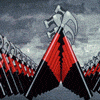 Kusari-gama
Kusari-gama
Kusari-gama (Alt. Kasurigama, Nagegama) is a traditional Japanese weapon that consists of kama (the Japanese equivalent of a scythe) on a metal chain with a heavy iron weight at the end. Though the kusari-gama is derived from a farmer's scythe, and though the scythe was often carried as a weapon by farmers during the feudal era of Japan, it is important to note that these farmers did not carry kusari-gama. Its purpose as a weapon was very obvious, so unlike a scythe, it could not be carried openly. The art of handling the Kusarigama is called Kusarigamajutsu.
Method of use
Attacking with the weapon usually entailed swinging the weighted chain in a large circle over one's head, and then whipping it forward to entangle an opponent's spear, sword, or other weapon, or immobilizing his arms or legs. This allows the kusari-gama user to easily rush forward and strike with the scythe.
A kusari-gama wielder might also strike with the spinning weighted end of the chain directly, causing serious or deadly injury to his opponent while still outside the range of the opponent's sword or spear.
Kusari-gama have also been employed as anti-siege weapons, with the chain allowing the weapon to be retrieved after it was thrown downwards at an attacking force.
Many fictional accounts of kusari-gama sometimes show fighters swinging the scythe with the chain, rather than the weighted end. Though entertaining, this is usually not a proper use of the weapon, as the scythe is likely to bounce off a target without causing much injury. One of the few exceptions to this is the Houten Ryu discipline of the kusari-gama.
Historical accounts of kusarigama
Attacking with the weapon usually entailed swinging the weighted chain in a large circle over one's head, and then whipping it forward to entangle an opponent's spear, sword, or other weapon, or immobilizing his arms or legs. This allows the kusari-gama user to easily rush forward and strike with the scythe.
A kusari-gama wielder might also strike with the spinning weighted end of the chain directly, causing serious or deadly injury to his opponent while still outside the range of the opponent's sword or spear.
Kusari-gama have also been employed as anti-siege weapons, with the chain allowing the weapon to be retrieved after it was thrown downwards at an attacking force.
Many fictional accounts of kusari-gama sometimes show fighters swinging the scythe with the chain, rather than the weighted end. Though entertaining, this is usually not a proper use of the weapon, as the scythe is likely to bounce off a target without causing much injury. One of the few exceptions to this is the Houten Ryu discipline of the kusari-gama.
[Dit bericht is gewijzigd door Schaep op 21-11-2007 0:00]









